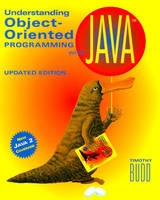
Understanding Object-Oriented Programming With Java
Pearson (Verlag)
978-0-201-61273-8 (ISBN)
- Titel erscheint in neuer Auflage
- Artikel merken
This book develops the object-oriented programming skills of experienced programmers (at the Junior, Senior or above level) by showing how to use Java 2 (the latest release of Sun's Java platform), and by providing a complete understanding of the philosophy behind Java 2. It starts out covering the language-independent concepts that are at the heart of the Java world, and then moves on to introduce Java through several example programs. Following this is an in-depth discussion on inheritance and polymorphism. Finally, the book concludes with material on important features of Java that are not object-oriented.
Timothy A. Budd is an Associate Professor of Computer Science at Oregon State University. Budd received his Bachelor of Arts degree in Mathematics and Computer Science from Western Washington University, and his masters and doctorate degrees in computer science from Yale University. His research interests include multi-paradigm programming languages, programming environments, compiler implementation and optimization techniques. 0201612739AB04062001
(Most chapters contain "Chapter Summary", "Study Questions", and "Exercises".)I: UNDERSTANDING THE OBJECT- ORIENTED WORLDVIEW.
1. Object-Oriented Thinking.
A Way of Viewing the World.
Computation as Simulation.
Chapter Summary.
Further Reading.
Study Questions.
Exercises.
2. A Brief History of Object-Oriented Programming.
The History of Java.
Client-Side Computing.
Security Issues.
The White Paper Description.
Chapter Summary.
Study Questions.
Exercises.
3. Object-Oriented Design.
Responsibility Implies Noninterference.
Programming in the Small and in the Large.
Why Begin with Behavior?
A Case Study in RDD.
CRC Cards-Recording Responsibility.
Components and Behavior.
Software Components.
Behavior and State.
Formalizing the Interface.
Designing the Representation.
Implementing Components.
Integration of Components.
Maintenance and Evolution.
Chapter Summary.
Study Questions.
Exercises.
II: UNDERSTANDING PARADIGMS.
4. A Paradigm.
Program Structure.
The Connection to the Java World.
Types.
Access Modifiers.
Lifetime Modifiers.
Chapter Summary.
Cross References.
Study Questions.
Exercises.
5. Ball Worlds.
Data Fields.
Constructors.
Inheritance.
The Java Graphics Model.
The Class Ball.
Multiple Objects of the Same Class.
Chapter Summary.
Cross References.
Study Questions.
Exercises.
6. A Cannon Game.
The Simple Cannon Game.
Adding User Interaction.
Chapter Summary.
Cross References.
Study Questions.
Exercises.
7. Pinball Game Construction Kit.
First Version of Game.
Adding Targets: Inheritance and Interfaces.
Pinball Game Construction Kit: Mouse Events Reconsidered.
Chapter Summary.
Cross References.
Study Questions.
Exercises.
III: UNDERSTANDING INHERITANCE.
8. Understanding Inheritance.
An Intuitive Description of Inheritance.
The Base Class Object.
Subclass, Subtype, and Substitutability.
Forms of Inheritance.
Modifiers and Inheritance.
Programming as a Multiperson Activity.
The Benefits of Inheritance.
The Costs of Inheritance.
Chapter Summary.
Study Questions.
Exercises.
9. A Case Study: Solitaire.
The Class Card.
The Game.
Card Piles--Inheritance in Action.
The Application Class.
Playing the Polymorphic Game.
Buildings More Complete Game.
Chapter Summary.
Study Questions.
Exercises.
10. Mechanisms for Software Reuse.
Substitutability.
Composition and Inheritance Described.
Composition and Inheritance Contrasted.
Combining Inheritance and Composition.
Novel Forms of Software Reuse.
Chapter Summary.
Study Questions.
Exercises.
11. Implications of Inheritance.
The Polyrmorphic Variable.
Memory Layout.
Assignment.
Equality Test.
Garbage Collection.
Chapter Summary.
Study Questions.
Exercises.
IV: UNDERSTANDING POLYMORPHISM.
12. Polymorphism.
Varieties of Polymorphism.
Polymorphic Variables.
Overloading.
Overriding.
Abstract Methods.
Pure Polymorphism.
Efficiency and Polymorphism.
Chapter Summary.
Further Reading.
Study Questions.
Exercises.
13. The AWT.
The AWT Class Hierarchy.
The Layout Manager.
Layout Manager Types.
User Interface Components.
Panels.
ScrollPane.
Case Study: A Color Display.
Dialogs.
'Me Menu Bar.
Chapter Summary.
Study Questions.
Exercises.
14. Input and Output Streams.
Input Streams.
Output Streams.
Piped Input and Output.
Chapter Summary.
Study Questions.
Exercises.
15. Design Patterns.
Adapter.
Composition.
Strategy.
Observer.
Flyweight.
Abstrac Factory.
Factory Method.
Iterator.
Decorator (Filter or Wrapper).
Proxy.
Bridge.
Chapter Summary.
Further Reading.
Study Questions.
Exercises.
V: UNDERSTANDING THE JAVA WORLD.
16. Exception Handling.
Information Transmitted to the Catch Block.
Catching Multiple Errors.
Termination or Resumptive Models.
Exceptions Thrown in the Standard Library.
Throwing Exceptions.
Passing On Exceptions.
Chapter Summary.
Study Questions.
17. Utility Classes.
Point.
Dimension.
Date.
Math.
Random.
Toolkit.
System.
Strings and Related Classes.
Chapter Summary.
Study Questions.
18. Understanding Graphics.
Color.
Rectangles.
Fonts.
Images.
Animation.
Graphics Contexts.
A Simple Painting Program.
Chapter Summary.
Study Questions.
Exercises.
19. Collection Classes.
Element Types and Primitive Value Wrappers.
Enumerators.
The Array.
The Vector Collection.
The Stack Collection.
The BitSet Collection.
The Dictionary interface and the Hashtable Collection.
Why Are There No Ordered Collections?
Building Your Own Containers.
Chapter Summary.
Study Questions.
Exercises.
20. Multiple Threads of Execution.
Creating Threads.
Case Study: A Tetris Game.
Chapter Summary.
Cross References.
Study Questions.
Exercises.
21. Applets and Web Programming.
Applets and HTML.
Security Issues.
Applets and Applications.
Obtaining Resources Using an Applet.
Combining Applications and Applets.
Chapter Summary.
22. Network Programming.
23. Java 2.
Appendices.
Java Operators.
Java Escape Characters.
Packages of the Java API.
Java Syntax Examples. 0201612739T04062001
| Erscheint lt. Verlag | 26.8.1999 |
|---|---|
| Sprache | englisch |
| Maße | 190 x 233 mm |
| Gewicht | 680 g |
| Themenwelt | Informatik ► Programmiersprachen / -werkzeuge ► Java |
| Informatik ► Software Entwicklung ► Objektorientierung | |
| Mathematik / Informatik ► Informatik ► Web / Internet | |
| ISBN-10 | 0-201-61273-9 / 0201612739 |
| ISBN-13 | 978-0-201-61273-8 / 9780201612738 |
| Zustand | Neuware |
| Haben Sie eine Frage zum Produkt? |
aus dem Bereich



